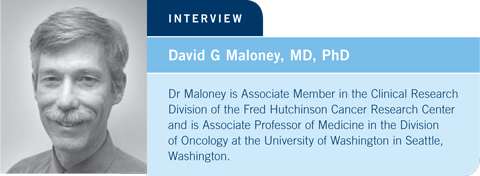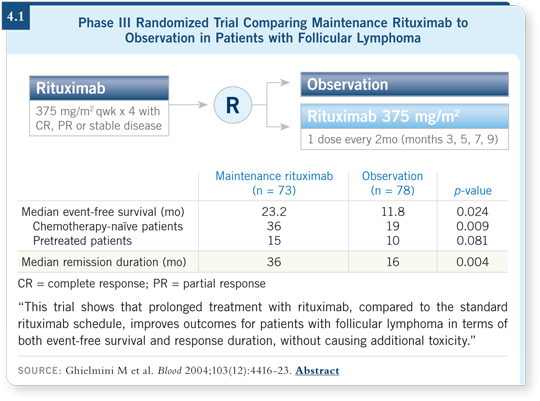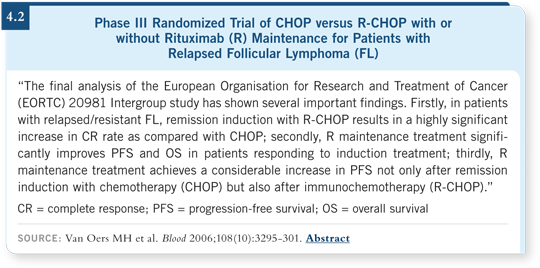

| Tracks 1-12 | ||||||||||||||||||||||||||
|
Select Excerpts from the Interview
Track 1
![]() DR LOVE: Would you discuss recent research advances in the management
of follicular lymphoma?
DR LOVE: Would you discuss recent research advances in the management
of follicular lymphoma?
![]() DR MALONEY: I believe we’re now clearly demonstrating that a number of
strategies are beginning to improve survival. This has predominantly been
accomplished through the inclusion of anti-CD20 antibody targeted therapies.
Rituximab has played the biggest role in this setting.
DR MALONEY: I believe we’re now clearly demonstrating that a number of
strategies are beginning to improve survival. This has predominantly been
accomplished through the inclusion of anti-CD20 antibody targeted therapies.
Rituximab has played the biggest role in this setting.
We have five trials indicating that by simply adding rituximab to standard chemotherapy, you obtain a better result (Czuczman 2005, 2004; Forstpointner 2004; Hiddemann 2005; Marcus 2005). This result has generally been in terms of improved progression-free survival, but several of the studies are beginning to show improved survival.
Track 4
![]() DR LOVE: Would you discuss the use of maintenance rituximab?
DR LOVE: Would you discuss the use of maintenance rituximab?
![]() DR MALONEY: I believe the role of maintenance rituximab is one of the key
unanswered questions in follicular lymphoma. It’s been shown that if you use
four doses of single-agent rituximab, then maintenance rituximab extends
progression-free survival (Ghielmini 2004; [4.1]). In that setting, we know
maintenance rituximab works.
DR MALONEY: I believe the role of maintenance rituximab is one of the key
unanswered questions in follicular lymphoma. It’s been shown that if you use
four doses of single-agent rituximab, then maintenance rituximab extends
progression-free survival (Ghielmini 2004; [4.1]). In that setting, we know
maintenance rituximab works.
Regarding patients with relapsed disease, van Oers recently published one of the most important studies, evaluating patients with relapsed follicular lymphoma who were still eligible to receive an anthracycline-containing regimen, which meant that they had received chlorambucil, CVP or a fludarabine-based regimen. The patients received CHOP or R-CHOP, and R-CHOP proved to be better, which was not a surprise (van Oers 2006; [4.2]).
A secondary randomization to two years of maintenance rituximab versus observation was also included. The group of patients who received CHOP benefited from maintenance rituximab, as did the group of patients who received R-CHOP.
That’s the closest we have come to suggesting that maintenance rituximab will work in follicular lymphoma. We even saw a survival advantage for the overall group in that trial (van Oers 2006; [4.2]).


Track 5
![]() DR LOVE: Can you discuss the ongoing clinical trials of maintenance
rituximab in follicular lymphoma?
DR LOVE: Can you discuss the ongoing clinical trials of maintenance
rituximab in follicular lymphoma?
![]() DR MALONEY: Two interesting trials are ongoing. The first is the PRIMA
study, which has completed accrual. Patients with follicular lymphoma were
treated with dealer’s choice for induction — R-CVP, R-CHOP, R-MCP or
R-FCM — and were then randomly assigned to either observation or maintenance
rituximab for two years. We are eagerly awaiting those results.
DR MALONEY: Two interesting trials are ongoing. The first is the PRIMA
study, which has completed accrual. Patients with follicular lymphoma were
treated with dealer’s choice for induction — R-CVP, R-CHOP, R-MCP or
R-FCM — and were then randomly assigned to either observation or maintenance
rituximab for two years. We are eagerly awaiting those results.
The RESORT study (ECOG-E4402) is a different approach, building on the Swiss trial that used four doses of rituximab followed by extended rituximab or not (Ghielmini 2004). The RESORT trial uses one dose of rituximab every three months indefinitely until tumor progression. The endpoint is to determine how long it takes to develop rituximab resistance. Does it occur faster in patients who are continuously exposed to rituximab compared to those who are treated only as needed, when they experience relapse?
Track 8
![]() DR LOVE: Where are we right now in the treatment of mantle-cell
lymphoma?
DR LOVE: Where are we right now in the treatment of mantle-cell
lymphoma?
![]() DR MALONEY: The use of bortezomib is causing the most excitement (Fisher
2006; [4.3]). The FDA has approved it for relapsed mantle-cell lymphoma.
People are trying to figure out how best to incorporate bortezomib earlier into
therapy. Many regimens are being reported with CHOP, in which vincristine is
dropped and bortezomib is added in various weekly or twice-weekly schedules.
DR MALONEY: The use of bortezomib is causing the most excitement (Fisher
2006; [4.3]). The FDA has approved it for relapsed mantle-cell lymphoma.
People are trying to figure out how best to incorporate bortezomib earlier into
therapy. Many regimens are being reported with CHOP, in which vincristine is
dropped and bortezomib is added in various weekly or twice-weekly schedules.
![]() DR LOVE: In your practice, how are you incorporating bortezomib?
DR LOVE: In your practice, how are you incorporating bortezomib?
![]() DR MALONEY: Generally speaking, I’m using it only for patients with relapsed disease. I’m not using it in the front-line setting. I haven’t seen anything yet
that makes me change my approach.
DR MALONEY: Generally speaking, I’m using it only for patients with relapsed disease. I’m not using it in the front-line setting. I haven’t seen anything yet
that makes me change my approach.

| Table of Contents | Top of Page |
EDITOR
Neil Love, MD
INTERVIEWS
Susan M O’Brien, MD
- Select publications
Robert Z Orlowski, MD, PhD
- Select publications
David P Steensma, MD
- Select publications
David G Maloney, MD, PhD
- Select publications
Hematologic Oncology Update:
A CME Audio Series and Activity